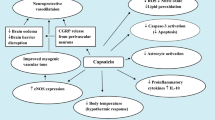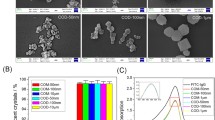Abstract
Capsaicin is a natural product of Capsicum peppers, excitatory effects of which have been shown to be mediated by the recently cloned vanilloid receptor 1 (VR1). Since previous studies have shown that capsaicin inhibits protein synthesis, experiments were performed to investigate whether this effect is mediated by VR1 receptor on cultured monkey kidney cells (Vero cells). The capsaicin uptake was assessed in cellular homogenate and in medium by high-performance liquid chromatography (HPLC) separation and quantification on C18 reverse-phase column and fluorescence detection. Toxic effects were assessed by incorporation of [3H]L-leucine into cellular proteins in the presence of capsazepine, the VR1 vanilloid receptor antagonist and Ruthenium red or tyrosine or calcium. Capsazepine (1 to 256 μM) did not modify the uptake rate of capsaicin for incubation times up to 24 h and did not antagonize capsaicin-induced protein synthesis inhibition. It rather inhibited protein synthesis per se from 100 to 256 μM. Ruthenium red which blocks mitochondrial calcium uptake, inhibited protein synthesis and did not antagonise or increase synergistically the effects of capsaicin. Interestingly in a medium deprived of calcium and supplemented by calcium chloride (10–50 μM) the protein synthesis inhibition induced by capsaicin is antagonised somehow. There was no prevention of capsaicin diffusion into the cells. Tyrosine, which seems to be the best preventive agent of capsaicin inhibitory effects, prevents its metabolism but not its diffusion. Capsaicin might enter cells by diffusion and interfere with protein synthesis machinery by competition with tyrosine which in turn prevents the metabolism of capsaicin. The results of the present study suggest that cell responses to capsaicin may be transduced through at least two molecular pathways, one involving VR1, since the receptor antagonist capsazepine fails to prevent the inhibitory effect of capsaicin in Vero cells of renal origin.
Similar content being viewed by others
Author information
Authors and Affiliations
Additional information
Received: 27 August 1999 / Accepted: 3 November 1999
Rights and permissions
About this article
Cite this article
Creppy, E., Richeux, F., Carratú, MR. et al. Cytotoxicity of capsaicin in monkey kidney cells: lack of antagonistic effects of capsazepine and Ruthenium red. Arch Toxicol 74, 40–47 (2000). https://doi.org/10.1007/s002040050650
Issue Date:
DOI: https://doi.org/10.1007/s002040050650




